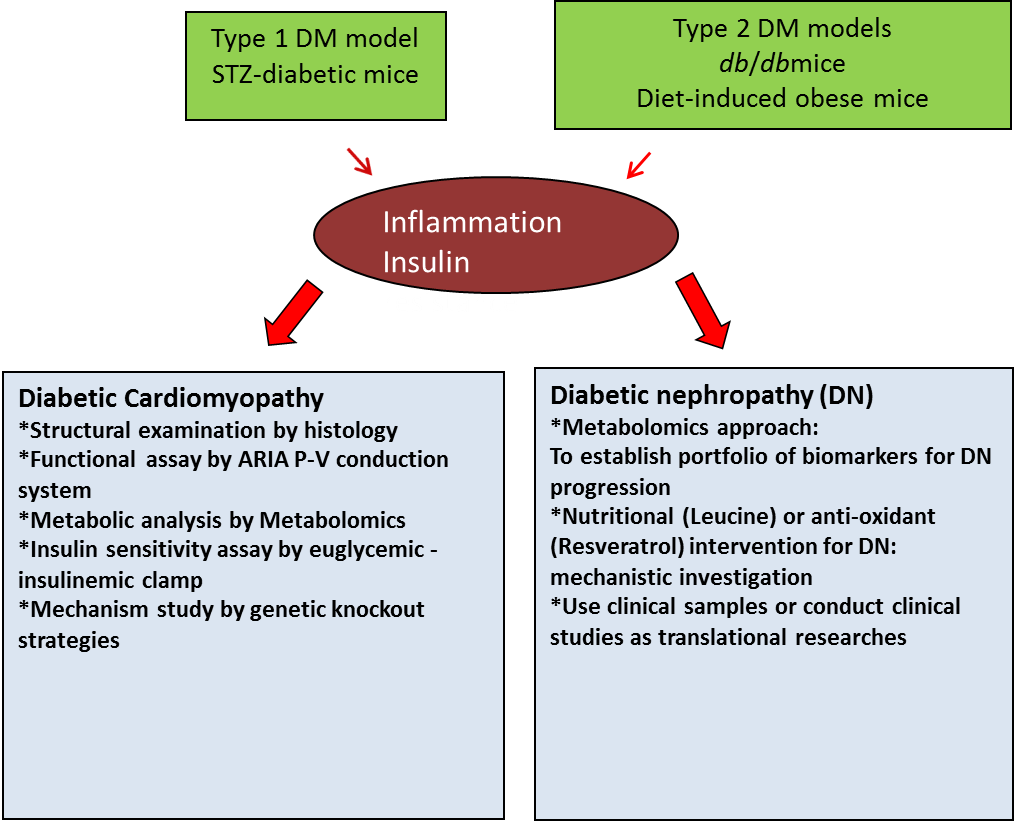Diabetes and Metabolic Syndromes
Diabetes and Metabolic Syndromes Research Team
 |
| PI: Li-Man Hung |
Research Expertise: Cardiovascular Physiology, Cardiovascular Pharmacology, Metabolomics, Biology
Researchers:
Prof. Jan-Kan Chen, Prof. Li-Man Hung and Dr. Kuan-Hsing Chen
Conceptual Framework:

General description
Diabetes mellitus (DM) has become one of the main threats to human health in the 21st century. Our understanding of the DM is largely on the detrimental effects of hyperglycemia and hyperlipidemia, including its pathophysiological effects on cardiovascular, renal and nervous systems. In recent years, research on the pathogenesis of DM and its complications have been focused on AGE-RAGE elicited signals and their effects, increased fatty acid levels and insulin resistance, adipocytes and adipokines, increased ROS and inflammation in a systemic nature etc.. Thus, a systemic, in vivo approach to study the DM-inflicted metabolic disorders appeared to be appropriate.
Background
Metabolic syndrome is a collection of multiple risk factors. Patients with metabolic syndrome are at twice risk for developing cardiovascular disease (CVD) and rise the risk about five times higher for type 2 diabetes mellitus (T2DM). Insulin resistance, dyslipidemia,oxidative stress, and inflammation are the key underlying mechanisms of metabolic syndrome. The contribution and interactions between these risk factors deserve great attention.
Aims
As an emerging platform technology in the post-genomic era, metabolomics is aimed to study the global profiling and variations of low-molecular-weight metabolites caused by pathophysiological stimuli and genetic variations. Metabolomics is most useful for the study of human degenerative diseases, which involve multiple risk factors like metabolic syndrome and T2DM.
Methods
We propose a relatively more holistic approach, the metabonomics, to detect, quantify, and catalogue the time related metabolic processes, and to relate such processes to the trajectories of the pathophysiological events occurring in DM.
Accomplishments
1. Huang JP, Cheng ML, Wang CH, Shiao MS, Chen JK & Hung LM*. High-fructose and high-fat feeding correspondingly lead to the development of lysoPC-associated apoptotic cardiomyopathy and adrenergic signaling-related cardiac hypertrophy.International Journal of Cardiology 215:65-76, 2016 (IF:4.036 )
2. Chen KH, Hsu HH, Yang HY, Tian YC, Ko YC, Yang CW, Hung CC. Inhibition of spleen tyrosine kinase (syk) suppresses renal fibrosis through anti-inflammatory effects and down regulation of the MAPK-p38 pathway. Int J Biochem Cell Biol. 2016 May;74:135-44. (IF: 4.046)
3. Chih-Chun Chang, Keng-Yang Lin, Kang-Yu Peng, Yuan-Ji Day & Hung LM*. Resveratrol exerts anti-obesity in high-fat diet obese mice and displays differential dosage effects on cytotoxicity, differentiation, and lipolysis in 3T3-L1 cells.Endocrine Journal63(2) 169-78, 2016(IF:1.997)
4. Yao J.Y., Liu C.K., Chen K.H., Chen J.K.* The amelioration of metabolic disorders in early stage diabetic rats by resveratrol is associated with mTORC1 regulation. J.Funct. Foods. 18:737-745,2015 (IF:3.574 )
5. Lou B.S., Wu P.S., Hou C.W., Cheng F.Y., Chen J.K.* Simultaneous quantification of trans-resveratrol and its sulfate and glucuronidemetabolites in rat tissues by stable isotope-dilutionUPLC–MSMS analysis.J. Pharmaceut Biomed. 94:99-105 , 2014 (IF:2.979 )
6. Lin S.S., Ueng S.W., Niu C.C., Yuan L.J., Yang C.Y., Chen W.J., Lee M. S., Chen J.K.* Effects of hyperbaric oxygen on the osteogenic differentiation of mesenchymal stem cells. BMC MUSCULOSKEL DIS. 15(56) , 2014 (IF:1.898 )
7. Hung LM, Huang JP, Liao JM, Yang MH, Li DE, Day YJ, Huang SS. Insulin renders diabetic rats resistant to acute ischemic stroke by arresting nitric oxide reaction with superoxide to form peroxynitrite. Journal of Biomedical Science18 (1): 47, 2014. (IF: 2.736)
8. Chang CC, Yang MH, Tung HC, Chang CY, TSAI YL, Huang JP, YEN TH & Hung LM*.Resveratrol exhibits differential protective effects on fast- and slow-twitch muscles in streptozotocin-induced diabetic rats. Journal of Diabetes6 (1): 60-7, 2014 (IF:2.349 )
9. Huang SS, Lu YJ, Huang JP, Wu YT, Day YJ & Hung LM*. The essential role of eNOS activation in insulin-mediated neuroprotection against ischemic stroke in diabetes.Journal of Vascular Surgery59 (2): 483-91, 2014 (IF:2.980 ).
10. Jing Y.H., Chen K.H., Kuo P.C., Pao C.C., Chen J.K.*Neurodegeneration in streptozotocin-induced diabetic rats is attenuated by treatment with resveratrol. Neuroendocrinology. 98:116-127, 2013 (IF: 4.373 )
11. Chen KH, Hsu HH, Lee CC, Yen TH, Ko YC, Yang CW, Hung CC*. The AMPK Agonist AICAR Inhibits TGF-β1 Induced Activation of Kidney Myofibroblasts. PLoS One. 2014 Sep 4;9(9):e106554 (IF: 3.234)
12. Liu YK, Chen KH, Leu YL, Way TD, Wang LW, Chen YJ, Liu YM. Ethanol extracts of CinnamomumkanehiraiHayata leaves induce apoptosis in human hepatoma cell through caspase-3 cascade. Onco Targets Ther. 2014 Dec 31;8:99-109(IF: 2.311)
Contact: Mr. Cheng yubimilk@mail.cgu.edu.tw
03-2118800#3200
